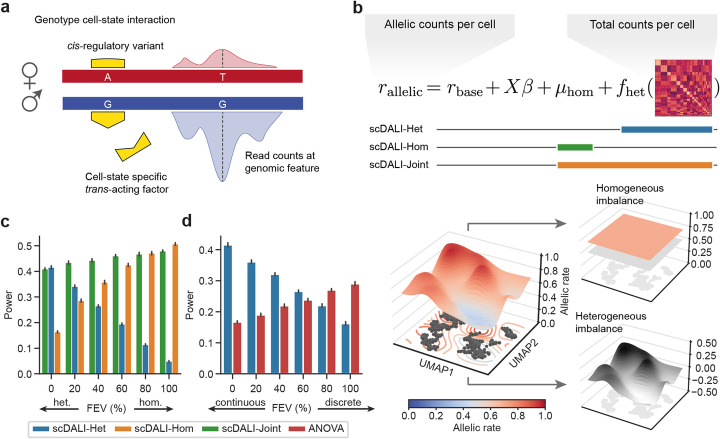Fig. 1.
scDALI overview and model validation using simulated data. a Illustration of the causes and quantification of allelic imbalance. Heterozygous variants within quantified genomic features (T and G variant) are used to assign reads to either haplotype. A cis-regulatory genetic variant (A and G variant, yellow) impacts the efficacy of a trans-acting factor on the maternal allele, which results in allelic imbalance. If the trans-acting factor is cell-state specific, this effect will be heterogeneous across cell states, otherwise homogeneous. b Integration of total and allelic counts per cell. scDALI models allelic imbalance in single cells as the sum of a fixed expected rate (rbase, e.g., 0.5 for autosomes), optional covariates, a global homogeneous component (μhom), and a heterogeneous cell state-specific component (fhet), which is characterized by a cell state kernel matrix. Three alternative score tests allow for assessing the evidence for global allelic imbalance (scDALI-Hom), heterogeneity across cell states (scDALI-Het), or to jointly test for either form of allelic imbalance (scDALI-Joint). c, d Assessment of power of alternative tests for allelic imbalance using simulated data. Allelic counts were simulated using alternative cell state kernels derived from real data (Additional file 1: Fig. S2, Methods). c Varying the simulated fraction of explained variance (FEV) of heterogeneous vs. homogeneous allelic imbalance. Whereas scDALI-Het and scDALI-Hom detect signals with simulated persistent or heterogeneous effects respectively, scDALI-Joint identifies either type of allelic imbalance. d Varying between simulating from a discrete and continuous cell state model. Shown are results from scDALI-Het and a baseline based on ANOVA to test for differences between discrete cell clusters (24 clusters; Methods)

